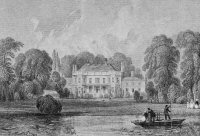

St Mary's
The medieval parish church stood near the manor house. But it was demolished and rebuilt on the present site in 1543. Only the tower remains of this building.

Click the icon for a history of St. Mary's Mortlake
Barn Elms

It is not known when the medieval manor house of Barn Elms was built or what it looked like. But it was demolished in 1694 and replaced by this mansion which stood until 1954.
Click on the icon for more about the Barn Elms estate
Milbourne House
A house of this name has stood on this site since the fifteenth century. The current Milbourne House is the oldest surviving house in Barnes. It assumed its present form in the eigtheenth century, but the main structure is probably sixteenth century. Only a public outcry prevented its demolition in 1945.
Click on the icon for more about Milbourne House
Portobello House
Portobello House was built around 1750 by Vice-Admiral Perry Mayne who took part in the battle of Porto Bello in 1738. It became the home of a Roman Catholic family named Gandolphi who converted the hayloft into a chapel for the local congregation. The house was demolished in 1893.
Click on the icon for more about Portobello House
Cromwell House
Old Cromwell House (below) was built in the sixteenth century. It was demolished in 1857 and a second Cromwell House was then built in the grounds by James Wigan.

Click on the icon for more about Cromwell House
Hammersmith Bridge
The first Hammersmith Bridge was opened in 1827 creating a direct route from Barnes to London and reducing the reliance on local watermen. The original bridge soon proved inadequate for the volume of traffic and was replaced by the present bridge in 1887

Coming of the Railway
Barnes and Mortlake were original stations on the Richmond Railway from Clapham Junction which opened in 1846 but was soon absorded into the London and South Western Railway. The original Barnes station has survived but Mortlake has been rebuilt twice on the same site. The other two stations in the area were opened later: Barnes Bridges in 1916 and North Sheen in 1930
Click the icon for an article from the Newsletter
Mortlake Manor House and Brewery
Mortlake's manor house stood to the east of Ship Lane. From the eleventh century it was a residence of the Archbishops of Canterbury until Henry VIII took it into his own hands. It is now the site of the older part of Mortlake Brewery.
Click the icon for more about the Brewery
St Mary's Church Barnes
St Mary's has stood on its present site since the first half of the twelfth century. It began as a small rectangular flint chapel. It was enlagred in 1215 and a tower was added around 1485. A fire in 1978 brought it close to destruction but the south and east walls of the medieval chapel and the Tudor tower survived.

The Limes
In the eighteenth century a number of large houses stood facing Mortlake High Street with gardens running down to the river. The Limes, built in 1720, is the largest and most imposing of the survivors. In the 1820s Turner painted two pictures of the house and the riverside terrace. In 1895 The Limes became the office of the newly-created Barnes Urban District Council.
Click on the icon for more about The Limes
Dee, Tapestry Works and the Queen's Head

John Dee the renaissance scholar and scientist, came to Mortlake in 1566 and lived in a house opposite the Church. His estate was purchased to set up the Tapestry Works in 1619. The Queen's Head was built on land bought after the closure of the Tapestry Works in the early eighteenth century.
Barnes Common and Mill Hill

From medieval times commons were an integral part of the village economy. Barnes Common has been nibbled away by enclosure and the construction of roads and railways, but a great deal has survived. In the centre of the Common at its highest point is the site of the former village mill where corn was once ground.
St. Mary Magdalen
Roman Catholic Church, designed by Gilbert Blount in Gothic style, was opened in 1852. The adjacent cemetery contains the curious mausoleum of Sir Richard Burton the explorer.
Click the icon for more about the Church and Cemetery
World War II Air Raid Shelter
Built around 1939 underneath the central garden of St Leonards Court. The shelter consists of a central corridor with two rooms off each side. Two rooms were the 'day area' with benches. The other two were the 'night area' with space for over 40 bunks, each with a shelf, an electric light, and a numbered hook for clothes. There are four chemical lavatories, a boiler, and a junction box for electricity (powered, in wartime, by a generator on the roof of the shelter). The entrance to the shelter is housed in a conical tower above ground. The future of the shelter is in doubt, given the redevelopment plans that are being vigorously opposed by the residents and the Society.
Hampton Square
Hampton Square was a concentration of mid-nineteenth century terraced houses located in the area now occupied by the Sheen Lane Centre.
Click the icon for the memories of life in this community in the 1920s and 1930s recounted by Reg East and George Wilding, two erstwhile inhabitants of Hampton Square.